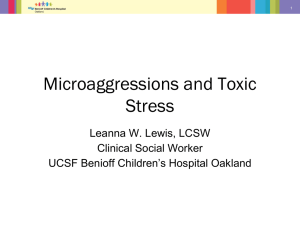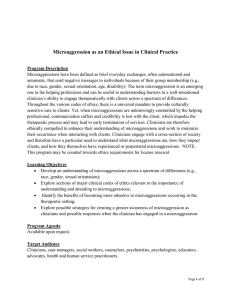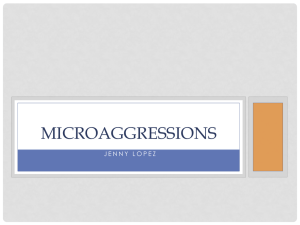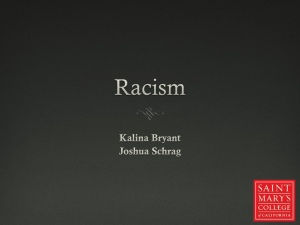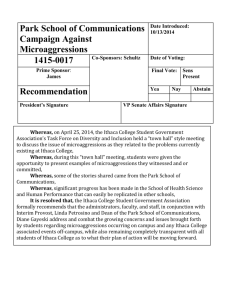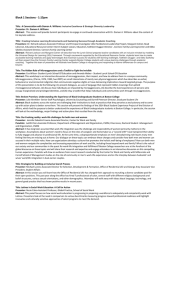Mental Toughness in Academia: Women Pursuing STEM Majors 24
advertisement
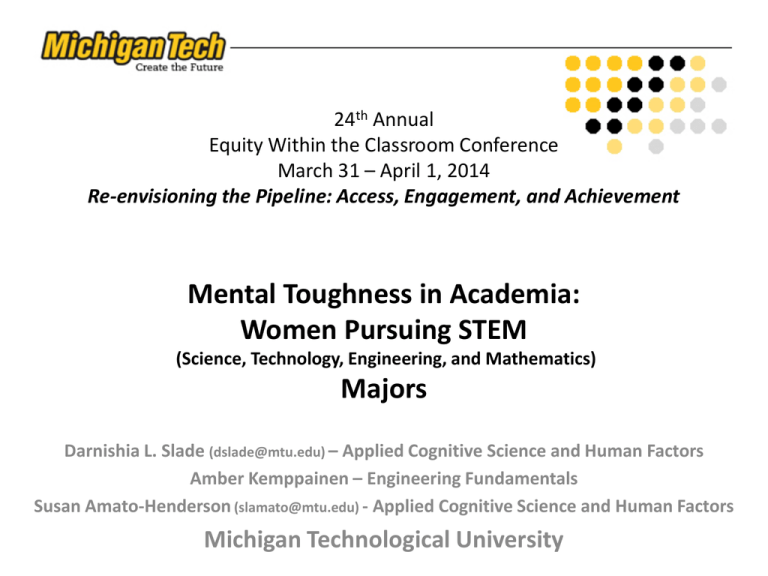
24th Annual Equity Within the Classroom Conference March 31 – April 1, 2014 Re-envisioning the Pipeline: Access, Engagement, and Achievement Mental Toughness in Academia: Women Pursuing STEM (Science, Technology, Engineering, and Mathematics) Majors Darnishia L. Slade (dslade@mtu.edu) – Applied Cognitive Science and Human Factors Amber Kemppainen – Engineering Fundamentals Susan Amato-Henderson (slamato@mtu.edu) - Applied Cognitive Science and Human Factors Michigan Technological University Darnishia L. Slade • First year PhD Student in Applied Cognitive Science and Human Factors – – Advisor, Dr. Susan Amato-Henderson Social Motivation, Affect & Cognition Lab (SMAC Lab) • Recruiter for Michigan Technological University for over 8 years • King-Chavez-Parks Initiative – Future Faculty Fellow • Detroit Native – DPS Bourne Outline • The Need… • Microaggressions • Microaggressions Exploratory Research • Self-Efficacy • Mental Toughness Exploratory Research • Implications as Educators The Need… “U.S. companies face a severe shortfall of scientists and engineers with expertise to develop the next generation of breakthroughs.” —Bill Gates, Chairman of Microsoft, 2008 “There is a skills gap in this country—for every unemployed person in the United States, there are two STEM job postings. The gap will only widen if we don’t engage now to address STEM education at the elementary and high school levels.” —Richard K. Templeton, Chairman, President, and CEO of Texas Instruments, 2013 Women’s share of degrees in the physical sciences and mathematics remain well below those of men, particularly at the doctorate level. Women’s participation in engineering and computer sciences Remains below 30%. Since 2000, underrepresented minorities’ share in engineering and the physical sciences have been flat, and participation in mathematics has dropped. Microaggressions (MA) The everyday verbal, nonverbal, and environmental slights, snubs, or insults, whether intentional or unintentional, which communicate hostile, derogatory, or negative messages to target persons based solely upon their marginalized group membership. (Sue & Rivera, 2010) • The term originated by Dr. Chester Pierce – was originally only linked to race and has expanded to include other marginalized groups. • MA could be considered a shift from overt, violent and explicit manifestations to more covert, subtle, insidious. Microaggressions • • • • Racial (sexist) jokes and verbal comments Racial (sexist) slurs written in shared spaces Segregated spaces and unequal treatment Denial and minimization of racism (sexism). The most harmful forms of MA remain outside the level of conscious awareness. Current MA Research • • • • • • • LGBTQ Ethnicity Gender Religion Race Marginalized Groups Nationality MA Research Findings “Racial microaggressions may be innocuous, but they have a cumulative, powerful, and dramatic impact on the lives of Black Americans. It is clear that much more research needs to be done on racial microaggressions to tease out important mental health and equity implications.” (Sue, Capodilupo, and Holder, 2008) “This study makes a contribution to research on Asian (Gujarati) health by documenting that experiences of discrimination are associated with worse health, with some notable gender differences, as well as differences by length of residency in the U.S., English proficiency, and education.” (Yoshimama, Bybee, and Blazevski, 2012) “Spatial discrimination as a form of microaggression is persistent, pervasive, and largely invisible, a silent condemnation of the reality of supernormative body sizes. Like fat embodiment, it is important that we continue to study the very real and physical effects of spatial discrimination, an implicit, deniable form of bodily oppression and identity devaluation.” (Owen, 2012) MA Research Findings “Some individuals believe words cannot cause harm, and others minimize the effect of subtle, yet hostile, language such as “that’s so gay.” Unlike racial slurs, this phrase is frequently tolerated on college campuses. (Ton, 2010) It is necessary to understand that “that’s so gay” is a microaggression, not just an insensitive expression.” (Woodford, Howell, Kulick, and Silverschanz, 2013) “Teachers have a professional responsibility to maintain safe learning environments for their students, and that responsibility includes recognizing and responding to subtle bias in the classroom. Effective management of classroom bias should not only improve campus climates for diverse students but also teach lessons to all students about being responsible citizens in an increasingly multicultural society.” (Boysen, 2012) “Women may feel insulted, objectified, or degraded on an everyday basis, potentially leading to short-term psychological distress, as well as an array of mental issues, including depression, anxiety, body image issues, and lower self-esteem.” (Nadal, Hamit, Lyons, Weinberg and Corman 2012) Microaggressions "My hope is to make the invisible visible, microaggressions hold their power because they are invisible, and therefore they don't allow us to see that our actions and attitudes may be discriminatory." SMAC Exploratory Study #1 • Sue’s Focus – Primarily on the aggressor, the environment and society. • Our focus is on the receiver (victim), the person that’s perceiving the insult. Rationale: What types of MA, how common in academics? Definitions • Self-efficacy: Self-efficacy constitutes individuals' beliefs in their personal ability to accomplish tasks (Bandura, 1995) • Belongingness: Individuals have a need to have a certain personal area or space - 'a home' - in which to dwell that satisfies the pressing psychological need to belong (Weil, 1952) MA Recordings • 29 female STEM students participated in this exploratory study • Asked to observe all forms of microaggressions for 7 days • Voice recordings of who, what when, where and how • Rating of negative impact on themselves and “typical” others (1= no negative impact, 10= strong negative impact) No women’s bathrooms on the 5th floor of the Chemical Sciences building on the campus of Michigan Tech When I was talking to my boyfriend, he was at the grocery store downstate in Detroit and I was up here, and I said I wish I could be downstate grocery shopping with you and his response was I wish you could be down here doing the grocery shopping for me. A female student was asking a lot of questions during class and a few boys behind me were talking about it and one stated "does this girl think this class was designed just for her." In my organic lab every week we have to do a discussion before we start the lab and my TA will look at the male member in our group to answer the questions and to present to the class every single time...Even though I came up with the ideas from the discussion sheet. In the cafe sitting with some friends talking about making some decisions. A male friend then turned and says “everyone knows women can't make up their minds.” Today I had Orgo lab at 2 o'clock and the lab coats are buttoned the male way so it's really difficult for me to button them up. Challenges… – The students did not report a consistent amount of observations (some reported several, others reported none over the 7 days) 3 possible explanations: 1) Are they subtle/invisible to the victim? 2) Did they simply not happen? 3) Were the students simply not diligent in recording them? – Research adjustments moving forward • Daily check-in • An increased demographic of female STEM students Identifying MA “Because microaggressions are implicit in nature, they are often more difficult to identify.” (Paludi, 2013) “When women experience microaggressions, it is common for many to dismiss the incidents because they are brief and seemingly harmless.” (Capodilupo et al. 2010) My Current Situation… Why do freezing pipes burst Credit: Tom Grundy • Not because of ice build-up, but because of pressure. • Pipes are the most at risk outside of building insulation, or those in unheated interior areas. • Solution: access points – running water and insulation. The cumulative chronic effect of microaggressions can theoretically contribute to diminished or flattened confidence. (Watkins, 2012) Self-Efficacy An individual’s belief in his of her capacity to execute behaviors necessary to produce specific performance attainments within a specific context. (Bandura, 1977) The effects of MA “may” negatively impact selfefficacy. Common Model of Bandura Self-Efficacy Theory Mental Toughness (MT) Mental toughness is having the natural or developed psychological edge that enables you to: • Generally cope better than your opponents with the many demands (e.g., competition, training, lifestyle) that are placed on you as a performer • Specifically, to be more consistent and better than your opponents in remaining determined, focused, confident, resilient, and in control under pressure (Jones, Hanton, and Connaughton, 2002) Self-Efficacy and Mental Toughness Connections? MT is historically monitored in athletes (typically elite athletes). Little or no research exist related to mental toughness in academia. Are there similar attributes found in topperforming athletes as there are in female STEM students? Putting it all together SMAC lab Proposed Model, goal of current and future research STEM Persistence /Retention Gender Based Microaggressions in STEM academics Mental Toughness Sense of Belonging (core human motivation) SMAC Exploratory Study #2 • Surveyed the same 29 participants from study #1 • Utilized the “Psychological Performance Inventory” questionnaire developed by James Loehr in 1986 • Modified 42 self-reported questions to make them academic in nature versus athletic Sample Questions Before a major exam, I picture myself performing perfectly. I get angry and frustrated during challenging situations, The goals I set for myself as a student keep me working hard. My concentration is easily broken. Scale: 1 2 3 4 5 Almost Always Often Sometimes Seldom Never Almost Mental Toughness PPI-A Factors SMAC Lab Factors • Determination • Drive/Determination • Self-Belief • Confidence • Positive Cognition • Negative emotions • Visualization • Visualization • Adversity response Future Research • Additional measuring tools that will include not only questionnaires, but observations and experiments. • A larger subject pool to validate/confirm exploratory results. • Community College • Historically Black College and University The Connections Photo: Justin Lewis/Getty Images Long-term goals… Further expansion of the construct of mental toughness in academia and how mental toughness is developed/cultivated. Can mental toughness help to inoculated the effects of microaggressions? Enhance the ability to prepare and equip female and underrepresented minority STEM students’ success during their university matriculation as well as in their future careers. Conclusions What can we do to increase and sustain the number of female and URMs studying STEM? – Exposure to STEM fields at an early age – Reassuring environment during formative years – Inquiring “what are you prepared to do to be successful” (Damon Williams – Monday Morning Keynote) – Welcoming and engaging educational institutions (K-16) – “Loving them UP!” (Julia Putnam Monday Afternoon Keynote) Don’t let the pipeline freeze on your clock – Keep pushing/encouraging them through the pipe from Boggs School, to middle school, to prom, to college graduation – Do your best to not pass feces through the pipeline, do your part – Attack at the root! Do blame ice on a water build-up – Be passionate about what you do and where you are, and model the way Thank You.
